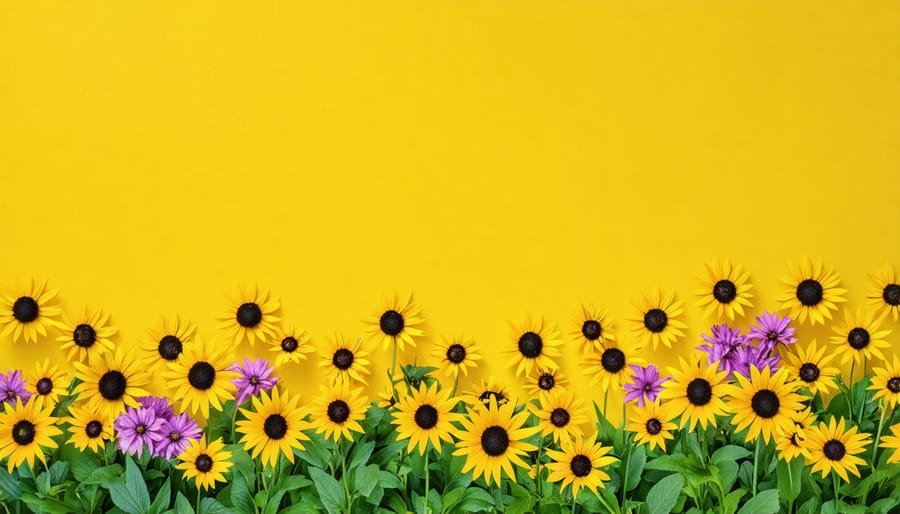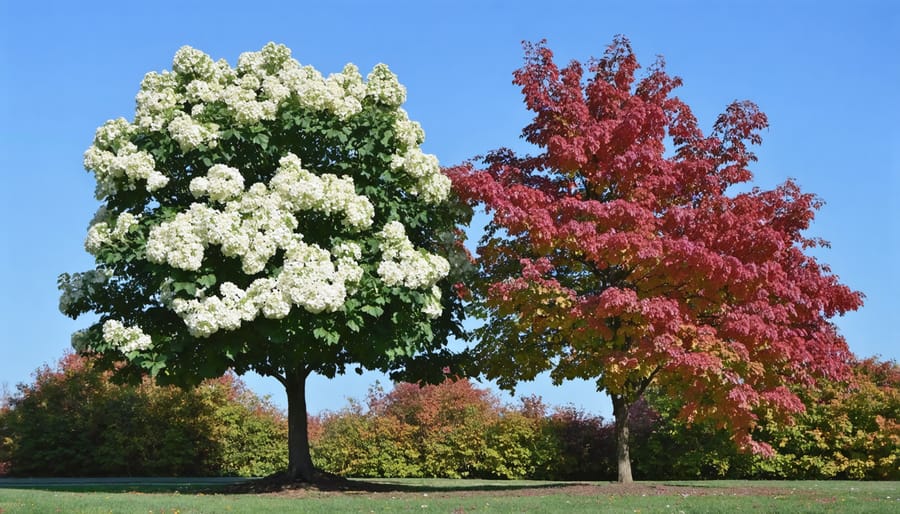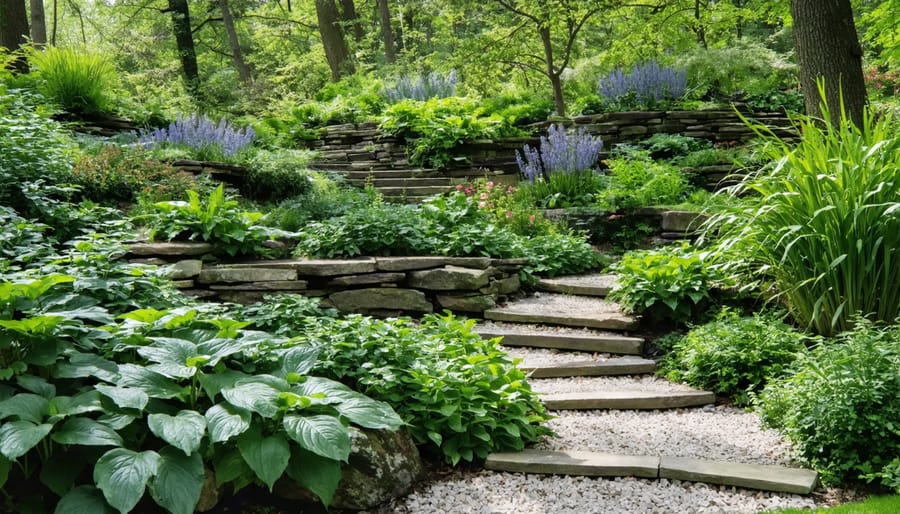Transform your zone 7a garden into a thriving native ecosystem by selecting powerhouse plants like Black-Eyed Susans, Purple Coneflowers, and New England Asters that naturally flourish in mid-Atlantic growing conditions. Group these indigenous species according to their water and sunlight needs to create self-sustaining plant communities that support local wildlife while requiring minimal maintenance. Incorporate eco-friendly landscaping practices by layering native groundcovers like Wild Ginger beneath taller perennials, naturally suppressing weeds and reducing water consumption. Plant spring ephemerals such as Virginia Bluebells and Trillium alongside summer-blooming natives to ensure year-round visual interest and continuous support for native pollinators. These robust plants adapt perfectly to zone 7a’s temperature swings between 0°F and 95°F, creating a resilient landscape that celebrates your region’s natural heritage while demanding less time and resources than non-native alternatives.
Best Native Plants for Zone 7a Gardens
Flowering Perennials
Transform your garden into a vibrant paradise with these stunning native flowering perennials that thrive in zone 7a. The Black-Eyed Susan (Rudbeckia hirta) stands out with its cheerful golden petals and dark centers, blooming from summer through fall. These hardy plants are perfect for sunny spots and require minimal maintenance once established.
Purple Coneflower (Echinacea purpurea) is another show-stopping native that adds both beauty and wildlife value to your garden. Its pink-purple blooms attract butterflies and bees throughout the summer, while its seed heads provide food for birds during winter. These drought-tolerant plants are excellent for creating natural borders or filling in perennial beds.
Don’t forget about Butterfly Weed (Asclepias tuberosa), a vital host plant for monarch butterflies. Its clusters of bright orange flowers create a stunning display from early summer to fall. Despite its delicate appearance, this perennial is incredibly tough and drought-resistant, making it perfect for busy gardeners.
For best results, plant these perennials in well-draining soil and full sun. While they’re low-maintenance, providing occasional water during establishment and removing spent blooms will encourage more flowering. These native beauties not only create a gorgeous garden display but also support local pollinators and maintain ecological balance in your landscape.

Native Shrubs and Trees
Native trees and shrubs form the backbone of any zone 7a landscape, providing year-round structure and vital habitat for local wildlife. The Oakleaf Hydrangea stands out as a stunning choice, offering large, cone-shaped white blooms in summer that transition to deep burgundy in fall, along with dramatic peeling bark for winter interest.
Red Maple is another excellent option, delivering reliable shade and spectacular fall color ranging from bright yellow to deep crimson. This adaptable tree thrives in various soil conditions and supports numerous native wildlife species. For smaller spaces, the Eastern Redbud offers a perfect solution, bursting with pink-purple blooms in early spring before its heart-shaped leaves emerge.
Consider incorporating American Holly for evergreen structure and winter berries, or Flowering Dogwood for its stunning spring display and fall fruit. Virginia Sweetspire adds fantastic fall color and works beautifully as a foundation planting or natural hedge. When planning your woody plant selections, remember to account for mature size and sun requirements to ensure your landscape thrives for years to come.

Ground Covers and Grasses
Ground covers and grasses are the unsung heroes of zone 7a gardens, offering both practical benefits and visual interest. Wild Ginger (Asarum canadense) creates a lush carpet of heart-shaped leaves in shady areas, naturally suppressing weeds while providing year-round ground coverage. This low-maintenance option thrives under trees and along woodland edges.
Little Bluestem (Schizachyrium scoparium) stands out among native grasses with its blue-green summer foliage that transforms into striking copper-red hues during fall and winter. Growing to about 2-3 feet tall, it’s perfect for creating movement and texture in sunny areas.
Other excellent ground cover options include Creeping Phlox (Phlox subulata), which blankets the ground with vibrant spring blooms, and Pennsylvania Sedge (Carex pensylvanica), which tolerates both sun and shade. For slope stabilization and erosion control, consider Green and Gold (Chrysogonum virginianum), which produces cheerful yellow flowers from spring through fall while maintaining a tidy, spreading habit.
Design Strategies for Native Plant Gardens
Creating Natural Plant Communities
Creating natural plant communities in your zone 7a garden isn’t just beautiful – it’s smart climate-ready garden design that works with nature, not against it. Start by observing which plants naturally grow together in your local area, then recreate these groupings in your yard.
Consider layering your garden with these compatible plant combinations:
– Tall trees like Oak or Black Cherry as the upper canopy
– Understory trees such as Dogwood or Redbud
– Shrubs like Viburnum or Native Hydrangea
– Ground covers including Wild Ginger or Green-and-Gold
Group plants with similar water and sunlight needs together. For example, pair drought-tolerant Black-Eyed Susans with Purple Coneflowers and Little Bluestem grass in sunny spots. For shaded areas, combine Wild Geranium, Foamflower, and Native Ferns.
Create “plant neighborhoods” by clustering species in odd-numbered groups of 3, 5, or 7. This mimics how plants grow in nature and creates visual impact. Remember to leave some space between clusters for plants to spread naturally over time.
By grouping compatible native plants together, you’ll create a low-maintenance landscape that supports local wildlife and thrives in your zone 7a conditions.

Four-Season Interest
Creating a garden that dazzles year-round might seem challenging, but zone 7a’s climate offers perfect opportunities for showcasing nature’s changing beauty through earth-friendly outdoor solutions. Start your four-season display with spring-blooming natives like Virginia bluebells and Eastern redbud trees, which burst with color as winter fades. Layer these with summer performers such as purple coneflowers and black-eyed Susans that provide vibrant colors and attract butterflies.
For autumn interest, incorporate native grasses like little bluestem, which turns a striking copper-red, and witch hazel shrubs that offer golden foliage. Don’t forget berry-producing plants like winterberry holly and American beautyberry – they’ll feed local birds while adding bold spots of color to your winter landscape.
Structure your garden with evergreen natives like Christmas fern and Eastern red cedar to maintain visual appeal during the coldest months. Consider placing these permanent elements strategically to frame seasonal shows and provide windbreaks. Include plants with interesting bark patterns, like river birch or oakleaf hydrangea, which reveal their artistic textures when leaves drop.
Remember to group plants with similar blooming periods together while mixing in species that shine in different seasons. This thoughtful arrangement ensures there’s always something catching the eye, no matter the month.
Maintenance Tips for Native Plant Success
First-Year Care
The first year is crucial for establishing native plants in your zone 7a garden. Start by planting in early spring or fall when temperatures are mild and rainfall is more frequent. Before placing your plants, prepare the soil by removing existing vegetation and loosening it to about 12 inches deep. Add a thin layer of compost if needed, but avoid over-fertilizing – native plants typically prefer lean soil conditions.
Water deeply but infrequently during the first growing season to encourage deep root growth. A good rule of thumb is to provide about 1 inch of water per week, either from rainfall or irrigation. Using a 2-3 inch layer of organic mulch around your new plants helps retain moisture and suppress weeds, but be sure to keep it away from plant stems to prevent rot.
Don’t be tempted to prune or cut back your native plants during their first year unless removing dead or damaged growth. This allows them to develop strong root systems and establish themselves properly. While native plants are generally low-maintenance, they’ll need extra attention during this establishment phase.
Monitor for signs of stress, such as wilting or yellowing leaves, and adjust care accordingly. If planting in fall, provide additional mulch before winter to protect roots from freeze-thaw cycles. By spring, you should see new growth emerging – a sign that your plants are settling in well.
Remember that even drought-tolerant natives need regular watering during their first year. Once established, they’ll become more resilient and require minimal care, rewarding you with years of natural beauty and ecological benefits.
Long-Term Management
Once your native plant garden is established, maintaining it becomes much easier than caring for traditional landscaping. The key is to understand and work with nature’s rhythms while implementing self-maintaining garden strategies that save time and effort.
Focus on these essential long-term maintenance practices: water deeply but infrequently to encourage strong root growth, typically once a week in the absence of rainfall. Mulch annually with 2-3 inches of organic material to suppress weeds and retain moisture. In spring, remove dead plant material and divide overcrowded perennials to maintain healthy growth patterns.
Resist the urge to deadhead all spent blooms – many native plants produce seeds that feed local birds and support natural reproduction. Leave some stems standing through winter to provide shelter for beneficial insects and visual interest during colder months.
Avoid fertilizing established native plants, as they’re adapted to local soil conditions. Instead, let fallen leaves decompose naturally to enrich the soil. Monitor for invasive species quarterly and remove them promptly to prevent them from overtaking your native plants.
Remember that a native garden evolves over time. Some plants may naturally spread while others might decline – this is normal and creates dynamic, living landscapes. Embrace this natural evolution while maintaining clear boundaries between different plant communities.
Document your garden’s changes through photos and notes each season. This helps you understand growth patterns and make informed decisions about future maintenance needs, ensuring your zone 7a native garden remains beautiful and sustainable for years to come.
Embracing native plants in your zone 7a garden is more than just a landscaping choice – it’s a commitment to creating a sustainable, thriving ecosystem right in your backyard. These resilient plants not only beautify your outdoor space but also support local wildlife, reduce maintenance needs, and contribute to the broader environmental health of your region.
By incorporating the native plants we’ve discussed, you’ll save time and money on maintenance while enjoying a garden that naturally flourishes in your local climate. These plants have evolved to handle zone 7a’s specific weather patterns, soil conditions, and seasonal changes, making them the perfect choice for both novice and experienced gardeners.
Remember, you don’t have to transform your entire landscape overnight. Start small by replacing a few non-native plants with indigenous alternatives, or create a dedicated native plant bed. As you witness the increased butterfly and bird activity, reduced water usage, and year-round visual interest, you’ll likely find yourself wanting to expand your native plant collection.
Take the first step today by selecting one or two native plants that catch your eye. Whether you’re drawn to the vibrant blooms of Black-Eyed Susans or the graceful structure of Little Bluestem, your garden – and the environment – will thank you for choosing plants that truly belong in your local ecosystem. Welcome to the rewarding world of native gardening in zone 7a!
